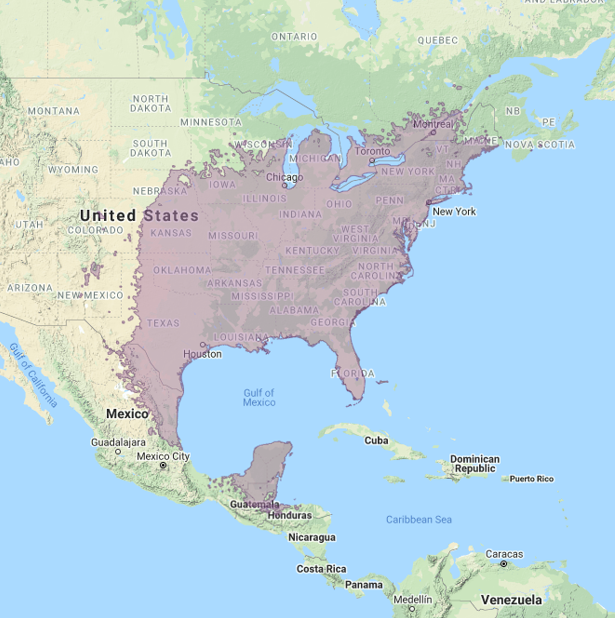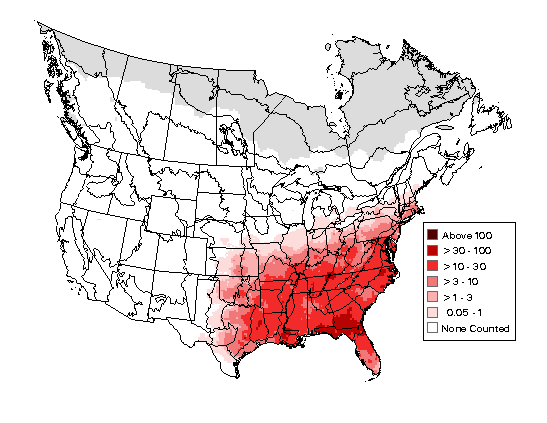Birdfinding.info ⇒ One of the most ubiquitous woodland and garden birds of the eastern U.S. (see Breeding Bird Survey Abundance Map in Notes below). The “White-browed” form is a common resident of the Yucatán Peninsula.
Carolina Wren
Thryothorus ludovicianus
Central and eastern North America south to Nicaragua, in various wooded and semiopen habitats.
Comprises two potentially distinct forms:
“Carolina Wren” (ludovicianus): eastern U.S. and adjacent southeastern Canada and northeastern Mexico. North to south-central Minnesota, the St. Lawrence Valley, and the Maritime provinces, west to the foothills of the Rocky Mountains in Colorado and New Mexico, and south to northern Veracruz and southern Florida. Often wanders north and west of its usual range.
“White-browed Wren” (albinucha): Yucatán Peninsula south to Tabasco, the Petén of Guatemala, and southern Belize, with two isolated populations: in interior valleys of southern Guatemala (around Chixoy) and in the border area of northwestern Nicaragua and adjacent Honduras.
Identification
A rusty wren with a long, bold eyebrow, warm-brown upperparts, and buffy underparts. Across most of its range, it overlaps primarily with the Northern House Wren, which is plainer and lacks Carolina’s bold eyebrow.

Carolina Wren, showing bold white eyebrow, buffy underparts, contrasting white throat, subtle barring on wings and tail, and black-and-white barring on outer primaries. (North Cabarrus Park, Kannapolis, North Carolina; January 23, 2020.) © Patty Masten
As with most wrens, the wings and tail are subtly barred blackish-and-brown. The barring on the outer primaries and outer tail feathers is typically black-and-white, but usually concealed or barely visible when the wings and tail are folded. Often has subtle white wingbars (usually just dots).
The underparts are usually some shade of buff, but highly variable: from creamy-whitish and orange-brown. The undertail and coverts are boldly barred with black.
The eyebrow is bold—sometimes pure-white and sometimes more whitish or buffy—and long, extending back to the nape, where it breaks up into streaks.
The upper throat and cheeks are whitish, usually in noticeable contrast with the otherwise buffy underparts. Usually shows subtle scaling or streaking on the cheeks.
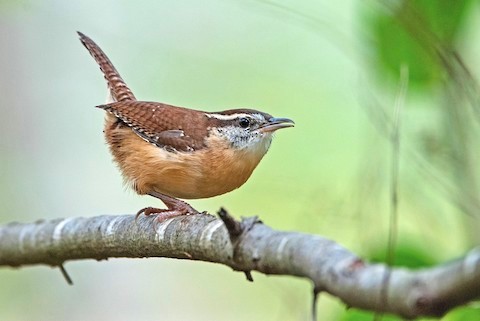
Carolina Wren. (Lake Conestee Nature Preserve, Greenville, South Carolina; October 25, 2019.) © Andrew Simon
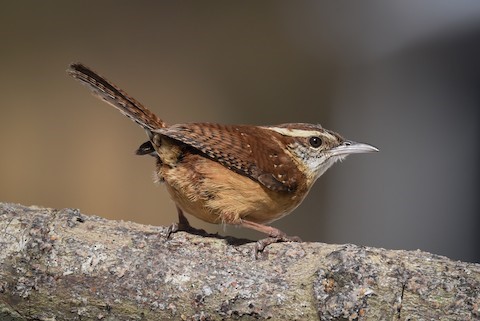
Carolina Wren. (Dartmouth, Massachusetts; March 12, 2017.) © Scott Martin
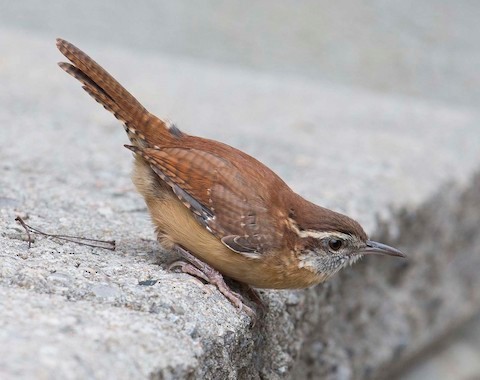
Carolina Wren. (Barnwell, Ottawa, Ontario; October 8, 2018.) © Tom Devecseri

Carolina Wren, singing. (Crescent Bend Nature Park, Cibolo, Texas; March 3, 2018.) © Ann Mallard

Carolina Wren, showing bold white eyebrow, buffy underparts, contrasting white throat and cheeks, subtle barring on wings and tail, and dotted white wingbars. (Rolla, Missouri; March 15, 2020.) © Gary Mueller
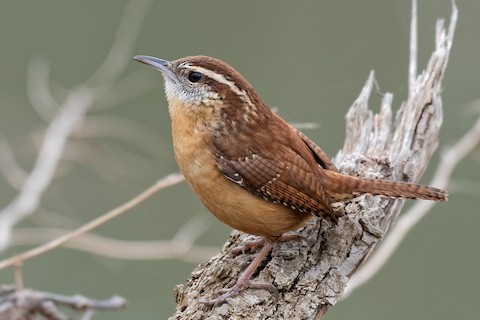
Carolina Wren with rich-buffy underparts. (Lake Isabella Park, Hamilton County, Ohio; December 26, 2019.) © Don Danko
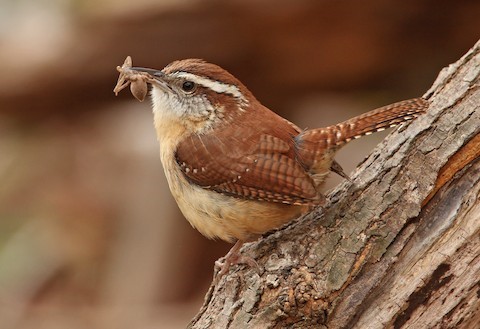
Carolina Wren in typical plumage, holding a spider. (Cape May, New Jersey; April 23, 2017.) © Christophe Buidin

Carolina Wren with pale-buffy underparts. (Crescent Bend Nature Park, Cibolo, Texas; March 4, 2018.) © Mike Stewart
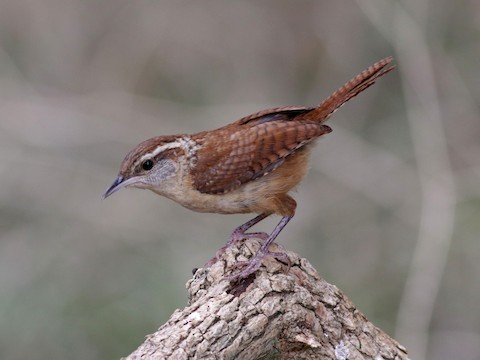
Carolina Wren with pale-buffy underparts and pronounced barring on the upperparts. (Crescent Bend Nature Park, Cibolo, Texas; August 3, 2019.) © Ann Mallard
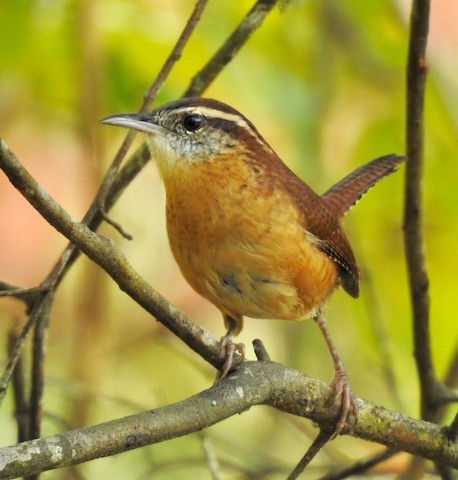
Carolina Wren with orange-buff underparts. (Tickfaw State Park, Livingston Parish, Louisiana; October 22, 2019.) © Van Remsen

Carolina Wren. (Beauharnois, Quebec; November 4, 2019.) © Suzanne Labbé

Carolina Wren with rich orange-buff underparts. (Bluebonnet Swamp Nature Center, East Baton Rouge, Louisiana; October 20, 2019.) © Van Remsen
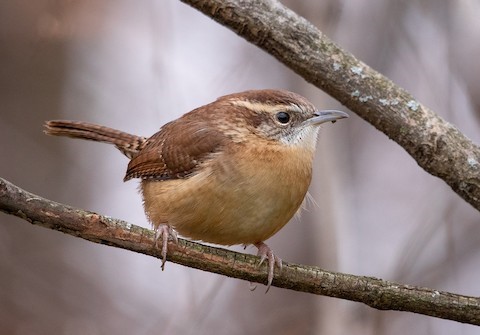
Carolina Wren. (Beauharnois, Quebec; November 4, 2019.) © Suzanne Labbé

Carolina Wren with mostly whitish underparts. (Brittania Conservation Area, Ottawa, Ontario; March 3, 2021.) © Gang Wu

Carolina Wren with feathers in disarray, showing white spots on wing coverts. (Firestone Metro Park, Akron, Ohio; April 14, 2017.) © Brian Tinker
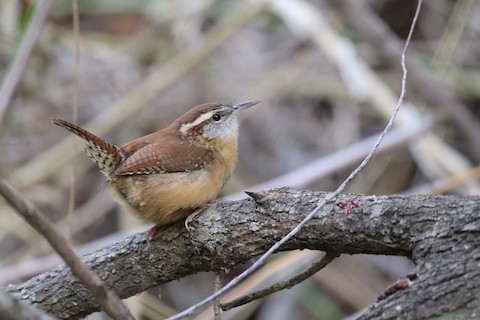
“Tamaulipas Wren” T. l. berlandieri, with coloration typical of northern Carolina Wren populations. (Frontera Audubon Center, Weslaco, Texas; November 11, 2019.) © Michael O’Brien
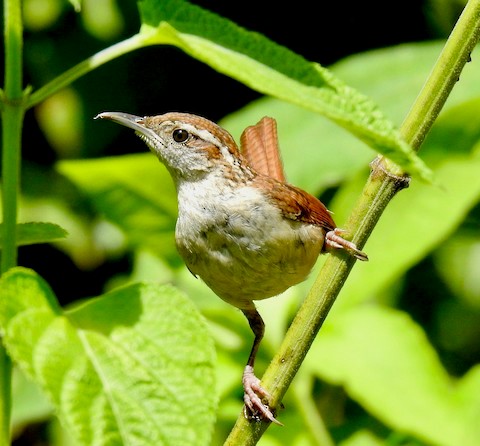
Carolina Wren with mostly whitish underparts. (Iberville, Louisiana; August 22, 2019.) © Van Remsen
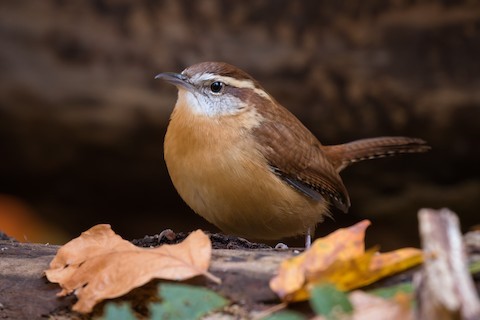
Carolina Wren with rich orange-buffy underparts extending up to the chin. (Miners Marsh, Kentville, Nova Scotia; October 28, 2020.) © Lyall Bouchard
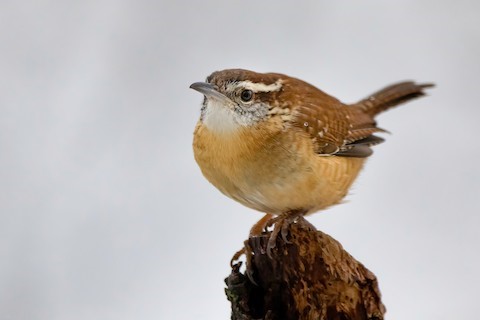
Carolina Wren, showing typical contrast between whitish throat and buffy underparts. (Newark, Ohio; January 31, 2021.) © Matthew Plante

“Tamaulipas Wren” T. l. berlandieri, with coloration typical of northern Carolina Wren populations. (Estero Llano Grande State Park, Texas; February 28, 2021.) © Cynthia Bridge

“Tamaulipas Wren” T. l. berlandieri, with rich orange underparts. (Chipinque Ecological Park, San Pedro Garza García, Nuevo León, Mexico; July 9, 2017.) © Patrick Van Thull

“Tamaulipas Wren” T. l. berlandieri, with pale-buffy underparts. (Estero Llano Grande State Park, Texas; January 5, 2021.) © Robin Gurule
“White-browed Wren”. The Yucatán and Central American populations are more variable than the northern ones. (Note that all populations have approximately the same vocalizations.)
In particular, the typical “White-browed” populations of the Yucatán (albinucha) usually have dingy whitish underparts, with little or no buffy shading, and somewhat colder-brown upperparts than the typical northern populations. As the name suggests, their brows are almost always white (not buffy).
However, some portion of the Yucatán populations are richer buffy below and rustier-brown above, similar to typical northern populations.
They also seem to be more variable in facial pattern—often with noticeable streaking on the cheeks and nape area.
The isolated populations of central Guatemala, southern Honduras, and northwestern Nicaragua (subfulvus) have coloration more similar to the typical northern populations, but somewhat duller.

“White-browed Wren” T. l. albinucha, showing plain whitish underparts. (Sendero de Xocen, Valladolid, Yucatán, Mexico; March 7, 2019.) © Ichi Nature Tours

“White-browed Wren” T. l. albinucha, with heavy streaking on the face and neck. (Benque Viejo Del Carmen, Belize; June 26, 2020.) © Isaias Morataya
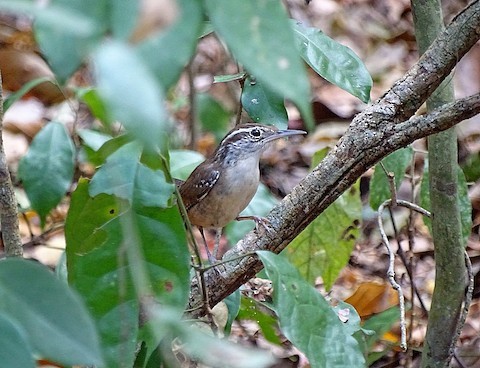
“White-browed Wren” T. l. albinucha. (Calakmul, Calakmul Biosphere Reserve, Campeche, Mexico; March 14, 2018.) © Jens Thalund
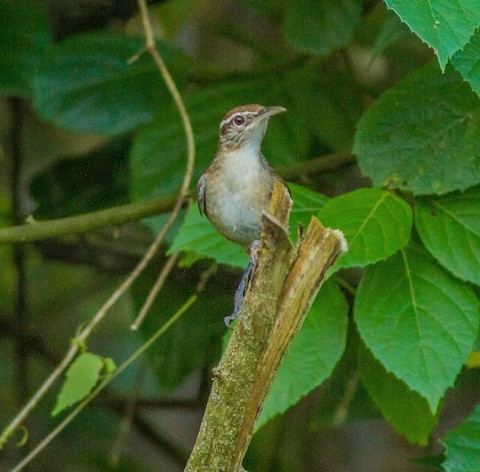
“White-browed Wren” T. l. albinucha. (San Antonio, Belize; March 16, 2018.) © Roni Martinez
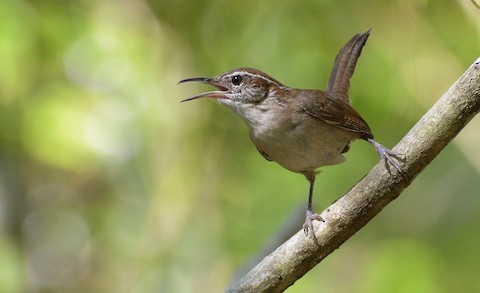
“White-browed Wren” T. l. albinucha. (Tayasal, Petén, Guatemala; June 8, 2019.) © Jorge Dangel
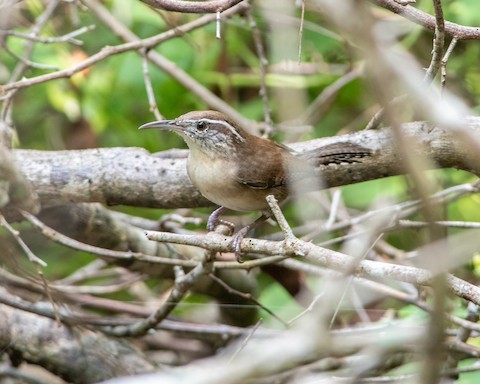
“White-browed Wren” T. l. albinucha. (Hochob Archaeological Zone, Campeche, Mexico; November 5, 2019.) © Hank Davis
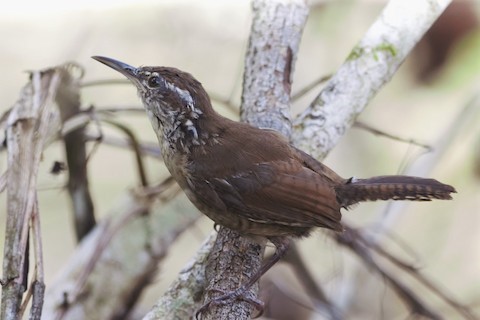
“White-browed Wren” T. l. albinucha, with heavy streaking on the face and neck. (Benque Viejo Del Carmen, Belize; September 13, 2020.) © Isaias Morataya
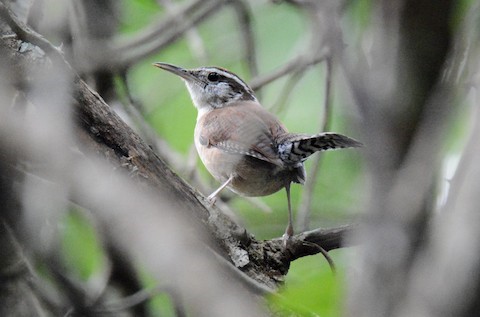
“White-browed Wren” T. l. albinucha. (Calakmul, Calakmul Biosphere Reserve, Campeche, Mexico; December 1, 2017.) © Kyle Kittelberger

“White-browed Wren” T. l. albinucha. (Balamku, Calakmul Biosphere Reserve, Campeche, Mexico; August 16, 2015.) © Rolando Chávez
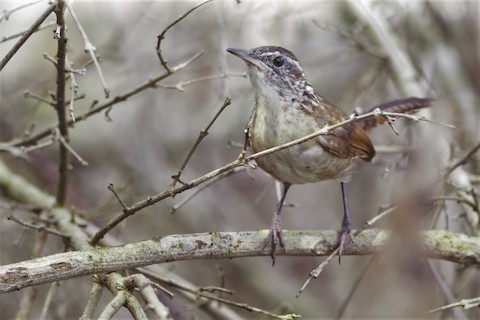
“White-browed Wren” T. l. albinucha. (Benque Viejo Del Carmen, Belize; September 13, 2020.) © Isaias Morataya
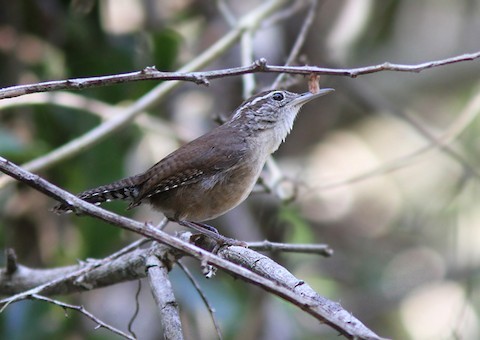
“White-browed Wren” T. l. albinucha, with coloration similar to northern Carolina Wren populations, but somewhat colder-brown upperparts. (Calakmul, Calakmul Biosphere Reserve, Campeche, Mexico; January 22, 2013.) © Amy McAndrews

“White-browed Wren” T. l. subfulvus, with mostly buffy underparts. (Santa Cruz Verapaz, Guatemala; January 19, 2020.) © John Cahill xikanel.com

“White-browed Wren” T. l. subfulvus, with coloration similar to northern Carolina Wren populations, but somewhat colder-brown upperparts. (Chinchayote, Choluteca, Honduras; October 17, 2019.) © Denilson Ordoñez

“White-browed Wren” T. l. subfulvus. (Chinchayote, Choluteca, Honduras; October 15, 2019.) © John van Dort
Cf. Bewick’s Wren. Bewick’s and Carolina Wrens overlap from Colorado east to Tennessee and south to Veracruz. They share habitat and have similar plumage patterns—and both vary in coloration enough to cause confusion.
On the underparts, Bewick’s is entirely whitish-gray, whereas Carolina is mostly buffy with a contrasting whitish throat. Carolina is more variable, and some individuals are much less colorful than average, but these outliers usually show creamy-whitish underparts, not gray like Bewick’s.
On the upperparts, Bewick’s is usually a dull or grayish shade of brown, whereas Carolina is always a warm rusty shade of brown. This difference is most consistent on the tail: Bewick’s typically has a gray-and-black tail, whereas Carolina’s tail appears mostly warm-brown.
Their songs differ. Carolina’s is loud and resonant, usually repeating a brief phrase a few times in succession. Bewick’s’ song is highly variable, but adheres to a different pattern: usually an introductory warble followed by a buzzy trill. The calls of both species probably vary too much to be useful in identification.
Cf. White-bellied Wren. The White-bellied Wren occurs alongside the “White-browed” form of Carolina Wren throughout the Yucatán Peninsula, and locally also with the northern or “Tamaulipas” form in northeastern Mexico. There is some potential for confusion with the “White-browed” as both have dull whitish underparts and distinct white or whitish brows.
White-bellied is noticeably smaller and rounder-bodied than “White-browed”, with a shorter tail, and its upperparts are usually a colder shade of brown (although both vary to some extent and potentially overlap in upperparts shading).
In song, White-browed typically gives a rapid strum of notes, whereas Carolina Wrens (including “White-browed”) have a loud and resonant song, usually repeating a brief phrase a few times in succession.
Cf. Cabanis’s Wren. “White-browed” and Cabanis’s Wrens overlap locally in Central America, where some populations of both seem to be atypical or variable. Visually, the most consistent difference is on the upperparts: “White-browed” is the same shade of brown from its crown to its tail, whereas Cabanis’s is grayer on the crown and nape, then progressively warmer shades of brown on the back, wings, and tail.
Cabanis’s’ typical songs consist of a quick phrase uttered at regular intervals. Sometimes it is a high-pitched, whistled phrase, and sometimes a richer, reverberating phrase. “White-browed” has a loud and resonant song, usually repeating a brief phrase a few times in succession.
Notes
Polytypic species consisting of ten recognized subspecies, subdivided into two distinct forms: “Carolina” (ludovicianus plus seven) and “White-browed” (albinucha and subfulvus). The southwesternmost populations of “Carolina” are also sometimes recognized as distinct: “Tamaulipas Wren” (berlandieri plus tropicalis), but the basis for such a distinction appears to be weak.
References
Alderfer, J., and J.L. Dunn. 2014. National Geographic Complete Birds of North America (Second Edition). National Geographic Society, Washington, D.C.
BirdLife International. 2018. Thryothorus ludovicianus. The IUCN Red List of Threatened Species 2018: e.T103887192A132201068. https://dx.doi.org/10.2305/IUCN.UK.2018-2.RLTS.T103887192A132201068.en. (Accessed June 7, 2021.)
eBird. 2021. eBird: An online database of bird distribution and abundance. Cornell Lab of Ornithology, Ithaca, N.Y. http://www.ebird.org. (Accessed June 7, 2021.)
Howell, S.N.G., and S. Webb. 1995. A Guide to the Birds of Mexico and Northern Central America. Oxford University Press.
Sibley, D.A. 2000. The Sibley Guide to Birds. Alfred A. Knopf. New York.
Xeno-Canto. 2021. Carolina Wren – Thryothorus ludovicianus. https://www.xeno-canto.org/species/Thryothorus-ludovicianus. (Accessed June 7, 2021.)

